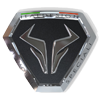As time goes by, technology is now increasingly developed and sophisticated. Not surprisingly, if nowadays many findings are unexpected even thought for a long time but have not been realized because of the limited technology in past. Call it one product that was successfully created thanks to the use of the latest technology is the flying cars.
 |
| Audi Pop.Up Next flying car concept developed along with Airbus and Italdesign has been shown at the Geneva International Motor Show 2018. (Picture from: http://bit.ly/2PgadtM) |
 Lately, the flying cars have been developed both by airlines and automotive manufacturers. As created by Audi which works together with a French commercial aircraft manufacturers, Airbus and the provider of development services for the automotive industry, Italdesign.
Lately, the flying cars have been developed both by airlines and automotive manufacturers. As created by Audi which works together with a French commercial aircraft manufacturers, Airbus and the provider of development services for the automotive industry, Italdesign.
Those three big companies have succeeded in making the flying car. Not only make, they also plan to do testing it in the air. And reportedly, the testing process of the flying car has been approved by the German government.
As reported by Carscoops, the car that has two seats will conduct a flight test in Ingolstadt, Germany. If the flying car manages to undergo the entire trial process and fly smoothly on the sky, the car will be produced in limited quantities and used as the flying taxi.
 |
| Left side view of Audi Pop.Up Next flying car concept. (Picture from: http://bit.ly/2OCIdkw) |
"Flying taxi is no longer a vision, they can bring us into new mobility. This is a great opportunity for old and new companies to develop new technologies, "said German Transportation Minister, Andreas Scheuer.
Recently, they also have introduced this flying car in March 2018 at the Geneva Motor Show 2018 automotive exhibition. And the flying car that is still in the form of the concept is named Audi Pop.Up Next.
This flying car is based on electricity and has implemented autonomous technology as well. This two passengers compact designed vehicle also has land and air modules. Yes, so as not to be too heavy, the manufacturers decided to make the car's body from carbon fiber materials. And the Pop.Up Next has a dimension of 2.6 meters long, 1.4 meters high and 1.5 meters wide.
 |
| Interior view of Audi Pop.Up Next flying car concept. (Picture from: http://bit.ly/2OCIdkw) |
On the landline modules, the Pop.Up Next relies on two electric motors that have a battery capacity of 15 kWh. And Audi promises the Pop.Up Next can spit out power equivalent to 80 horsepower and is believed to be able to drive 130 km for a single fully battery charge.
As for the flying modules that are equipped with four propellers like drones. Each propeller is powered by an electric motor of 26 horsepower which is packed with a battery with a capacity of 70 kWh.
 |
| Rear view of Audi Pop.Up Next flying car concept. (Picture from: http://bit.ly/2PgadtM) |
When the flight mode is activated, the maximum power that can be produced by all propellers is reach out 214 hp. For maximum speed when adjusting the flight module, it is possible for the Pop.Up Next to reach a top speed of up to 120 km/hour.
Furthermore, this Pop.Up Next only has a range of 50 km with a single fully battery charge. If the battery runs out, this capsule must be recharged for 15 minutes to be able operated again.
Unfortunately, so far there has been no detail information about when the Pop.Up Next is produced and sold to the public. Well, we'll wait for the next infos of this flying car. *** [EKA | FROM VARIOUS SOURCES | AUTOBLOG | PHYS.ORG | CARSCOOPS]
Note: This blog can be accessed via your smart phone


































